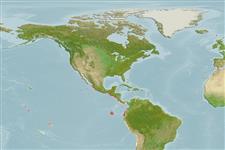Actinopterygii (ray-finned fishes) >
Perciformes (Perch-likes) >
Haemulidae (Grunts) > Haemulinae
Etymology: Anisotremus: Greek, anisos = unequal + Greek, trema, -atos = hole (Ref. 45335).
Environment / Climate / Range
Ecology
Marine; reef-associated; depth range 3 - 30 m (Ref. 5227), usually 3 - 12 m (Ref. 5227). Tropical, preferred ?; 22°N -
Eastern Pacific: Gulf of California to Peru, including the Galapagos Islands.
Size / Weight / Age
Maturity: Lm ? range ? - ? cm
Max length : 51.0 cm TL male/unsexed; (Ref. 55763); common length : 30.0 cm TL male/unsexed; (Ref. 9114); max. published weight: 3.6 kg (Ref. 40637)
Body compressed and deep (depth contained 2.0 to 2.1 times in standard length); mouth small and terminal with thick, fleshy lips; dorsal fin with 12 to 13 spines and 16 to 17 soft rays (XII-XIII, 16-17); pectoral fins slightly longer than head, reaching origin of anal fin; lateral line with 46 to 50 scales; scale series above lateral line oblique; body silvery yellow to green; large scales above lateral line with a dark anterior border, resembling spots; fins yellowish brown (Ref. 55763).
Solitary and found hiding in reefs and caves during the day (Ref. 9114). Juveniles appear in late summer and swim in schools. A nocturnal feeder on reef invertebrates (Ref. 9114). Marketed fresh (Ref. 9114).
Life cycle and mating behavior
Maturity | Reproduction | Spawning | Eggs | Fecundity | Larvae
Distinct pairing during breeding (Ref. 205).
Thomson, D.A., 1987. Reef fishes of the Sea of Cortez. The rocky-shore fishes of the Gulf of California. The University of Arizona Press, Tucson. 302 p. (Ref. 5592)
IUCN Red List Status (Ref. 115185)
CITES (Ref. 94142)
Not Evaluated
Threat to humans
Harmless
Human uses
Fisheries: commercial
More information
ReferencesAquacultureAquaculture profileStrainsGeneticsAllele frequenciesHeritabilityDiseasesProcessingMass conversion
Tools
Special reports
Download XML
Internet sources
Estimates of some properties based on models
Phylogenetic diversity index (Ref.
82805): PD
50 = 0.5039 [Uniqueness, from 0.5 = low to 2.0 = high].
Bayesian length-weight: a=0.02455 (0.01347 - 0.04474), b=3.06 (2.90 - 3.22), in cm Total Length, based on LWR estimates for this species & (Sub)family-body (Ref.
93245).
Trophic Level (Ref.
69278): 3.5 ±0.37 se; Based on food items.
Resilience (Ref.
69278): Low, minimum population doubling time 4.5 - 14 years (K=0.13).
Vulnerability (Ref.
59153): High vulnerability (58 of 100) .
